![]()
![]()
![]()
Use LEFT and RIGHT arrow keys to navigate between flashcards;
Use UP and DOWN arrow keys to flip the card;
H to show hint;
A reads text to speech;
58 Cards in this Set
- Front
- Back
|
Inspiration |
Movement of air from enviornment to alveoli |
|
|
Expiration |
opposite |
|
|
Alveoli |
Air-containing sacs that make up the lungs |
|
|
What is the main function of the respiratory system |
Supply the body tissues with oxygen and dispose of carbon dioxide |
|
|
What are the four processes that make up respiration? |
1. Pulmonary ventilation 2. External respiration 3. Transport of respiratory gases in the blood 4. Internal respiration |
|
|
External respiration, |
Movement of oxygen from the lungs into blood, carbon dioxide from blood to lungs |
|
|
Internal respiration |
Movement of oxygen from blood into tissue cells. Carbon dioxide from cells into blood. |
|
|
Respiratory zone |
Portion of the respiratory system where gas exchange happens |
|
|
Conducting zone |
Top of the trachea to the respiratory bronchioles |
|
|
what are goblet cells and cilia |
Located in the trachea. Smoking kills the cilia. |
|
|
What is the site of gas exchange |
Alveoli |
|
|
Type I alveolar cells |
The flat epithelial cells that line the air-facing surfaces of the respiratory system |
|
|
Type II alveolar cells |
Produce a detergent-like substance called surfactant |
|
|
Why is the alveolar surface area so large? |
To allow for the rapid exchange of oxygen and carbon dioxide by diffusion |
|
|
Pleura sac |
Sac that surrounds the lung. Consists of thin sheets of cells called Pleura |
|
|
Plurae |
Form a thin double-layered serosa
|
|
|
Parietal pleura |
Covers the thoracic wall |
|
|
Visceral pleura |
Covers the external surface of the lung |
|
|
Intrapleural fluid |
Fluid produced by the pleura. Contained in the pleural cavity. Lubricates the lung to prevent friction when breathing |
|
|
Pleurisy |
Infection or inflammation of the pleura. Often results from pneumonia. Causes toughening of the pleura and a buildup up fluid. |
|
|
Steps of respiration |
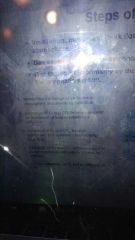
|
|
|
Boyles law |
P1V1=P2V2 |
|
|
Respiratory pressure is always relative to _________ |
Atmospheric pressure |
|
|
Palv |
Pressure in the alveoli |
|
|
When the pressure in the alveoli is less than that of the pressure in the atmosphere, air flows into the lung. When the opposite is true, air flows out |
Js |
|
|
Pip us the pressure where? |
In the pleural cavity Pip = Pav lungs collapse, |
|
|
Inspiration (breathing) |
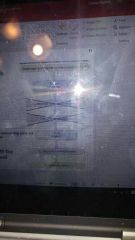
|
|
|
Expiration |
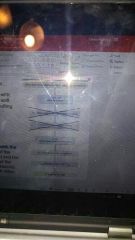
|
|
|
Lung compliance |
Greater lung compliance means that it is easier to expand the lungs |
|
|
What two things determine lung compliance |
1. Stretchability of lung tissues 2. Surface tension at the air water interfaces within the alveoli |
|
|
What can reduce surface tension |
Surfactants |
|
|
What is transpulmonary pressure |
Equal to the alveolar pressure minus the Intrapleural pressure. |
|
|
Image |
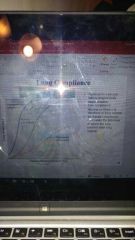
|
|
|
What does a decrease in surface tension do? |
Increases lung compliance and makes it easier to expand the lungs |
|
|
Airway resistance |
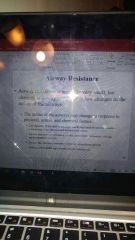
|
|
|
Asthma |
Asthma is caused when smooth muscle contracts strongly in the airway, increasing airway resistance. Chronic imflammation of the airways |
|
|
Chronic obstructive pulmonary disease |
Emphysemia, bronchitis or both Cause severe difficulty in ventilation and oxygenation of the blood |
|
|
Emphysema |
Caused by destruction and collapse of smaller airways |
|
|
Chronic bronchitis |
Excessive mucus production in bronchi Inflammation in small airways |
|
|
Lung volumes and capacities |
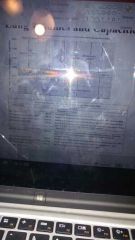
|
|
|
Dead space |
The amount of air that is taken in and cannot be used for gas exchange |
|
|
Anatomical dead space a |
Amount of air in the conducting zone |
|
|
Alveolar dead space |
The amount of air that enters alveoli that do not receive a sufficient supply of blood |
|
|
Respiratory Quotient (RQ) |
The ratio of CO2 produced to the amount of CO2 consumed |
|
|
How does the lung maximize efficiency? |
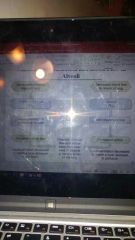
|
|
|
Hemoglobin |
Oxygen is transported in the blood by hemoglobin |
|
|
Hemoglobin cooperativity |
Means when one oxygen molecule binds to hemoglobin, the remaining three will bind much more easily |
|
|
Effect of various things on hemoglobin |
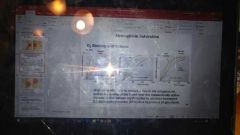
|
|
|
Transport of CO2 in blood |
10% dissolves in blood as CO2 30% carried by hemoglobin 60% converted to bicarbonate |
|
|
Hyperventilation vs hypoventilation |
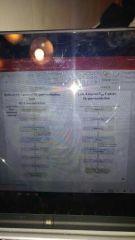
|
|
|
Peripheal vhemoreceptors |
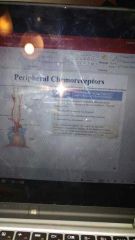
|
|
|
Result of exercise |

|
|
|
Protection of the respiratory system |
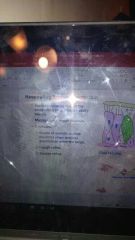
|
|
|
Hypoxia |
Inadequate oxygen delivery to tissues |
|
|
Anemic hypoxia |
Poor Oxygen delivery because of too few RBCs or abnormal hemoglobin |
|
|
Ischemic hypoxia |
Blood circulation is impaired |
|
|
Histoxic hypoxia |
Bodies cells are unable to use oxygen (cyanide) |
|
|
Hypoxemic hypoxia |
Reduced arterial oxygen |

